您好,登錄后才能下訂單哦!
您好,登錄后才能下訂單哦!
本篇內容介紹了“如何使用API v3接口”的有關知識,在實際案例的操作過程中,不少人都會遇到這樣的困境,接下來就讓小編帶領大家學習一下如何處理這些情況吧!希望大家仔細閱讀,能夠學有所成!
jdk:1.8 wechatpay-apache-httpclient:0.2.2
筆者以微信小程序支付接口為例展開說明,至于小程序注冊、認證、微信支付注冊本文概不說明。
登錄微信支付后臺,進入賬戶中心,API安全設置,如下圖 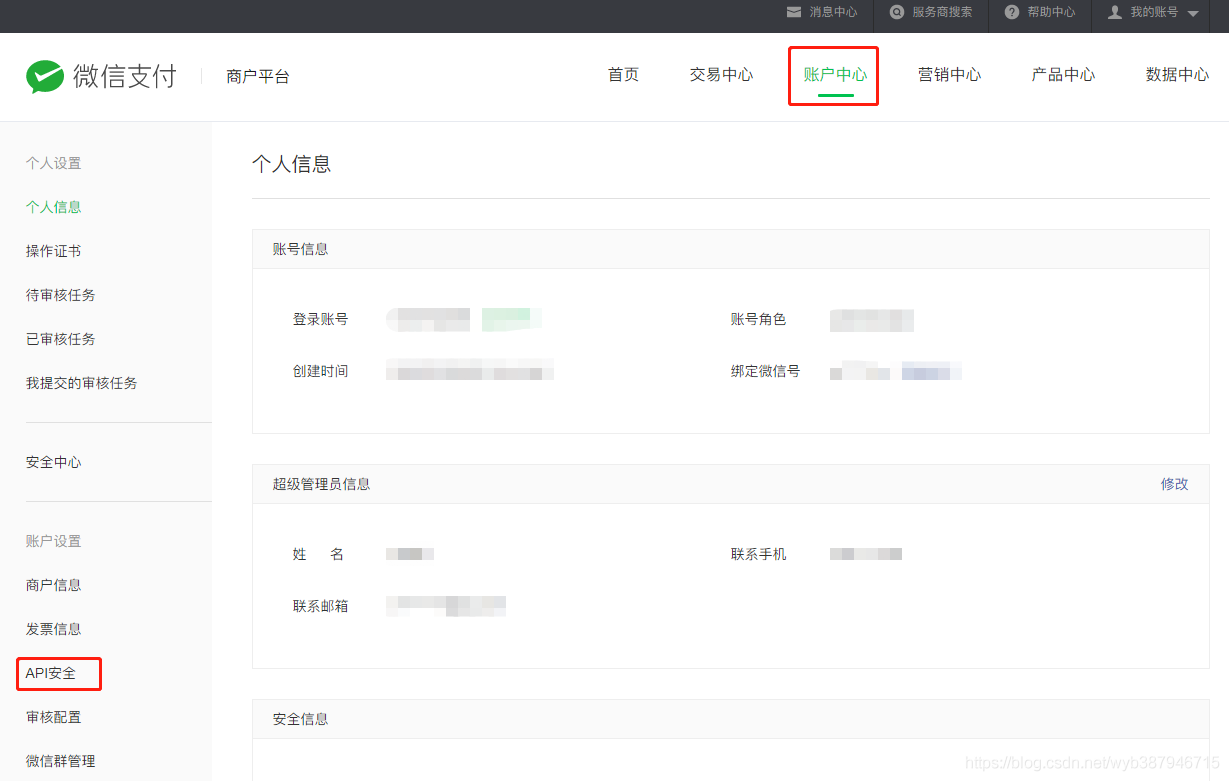 申請商戶證書,如下圖
申請商戶證書,如下圖 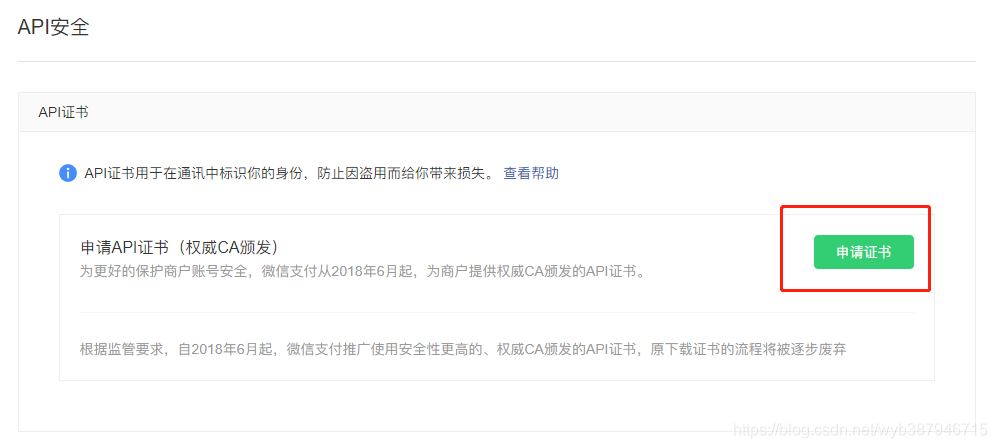 點擊“申請證書”按鈕后,彈出生成API證書申請框,如下圖
點擊“申請證書”按鈕后,彈出生成API證書申請框,如下圖 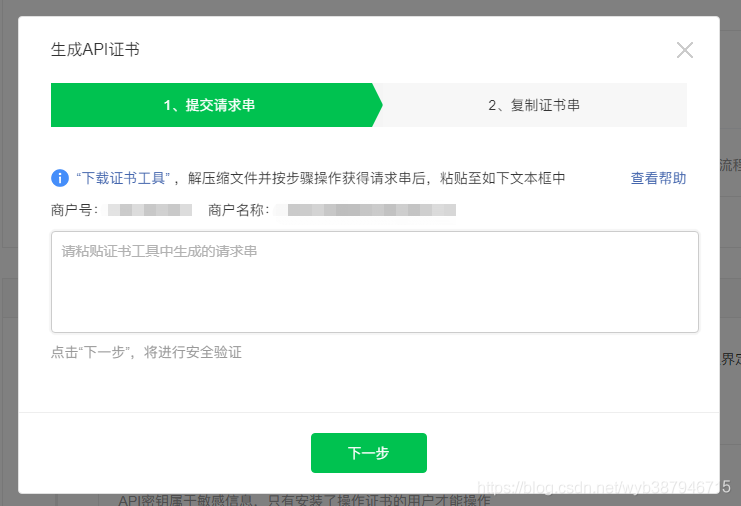 根據提示下載證書工具,當前頁面不要關閉,下載證書工具后打開,如下圖
根據提示下載證書工具,當前頁面不要關閉,下載證書工具后打開,如下圖 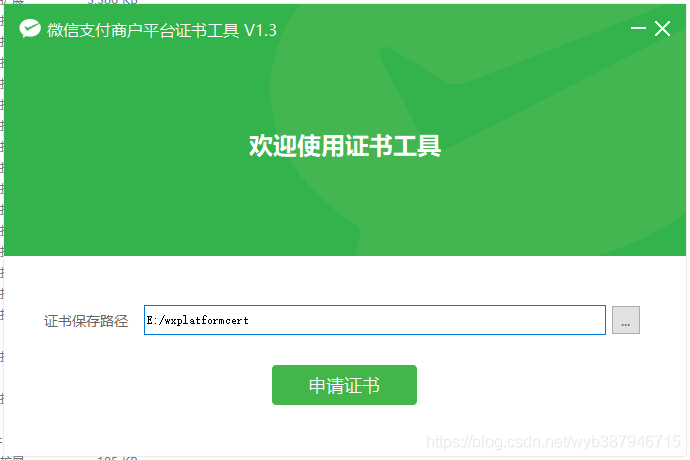
點擊“申請證書”按鈕后,進入填寫商戶信息界面,商戶信息經測試是自動填充的,如下圖 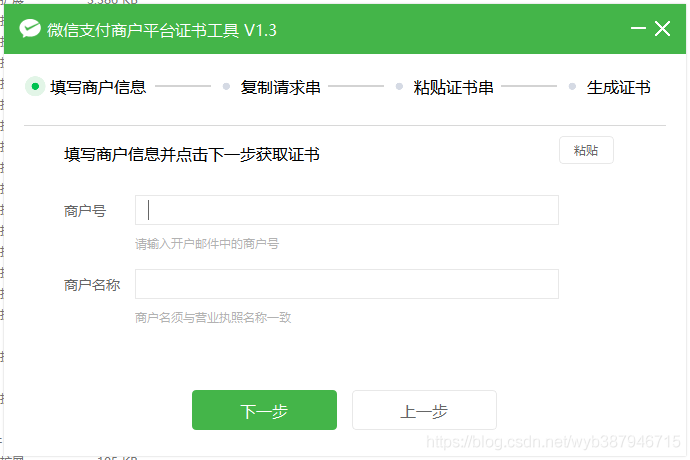 點擊“下一步”,進入復制請求串界面,如下圖
點擊“下一步”,進入復制請求串界面,如下圖 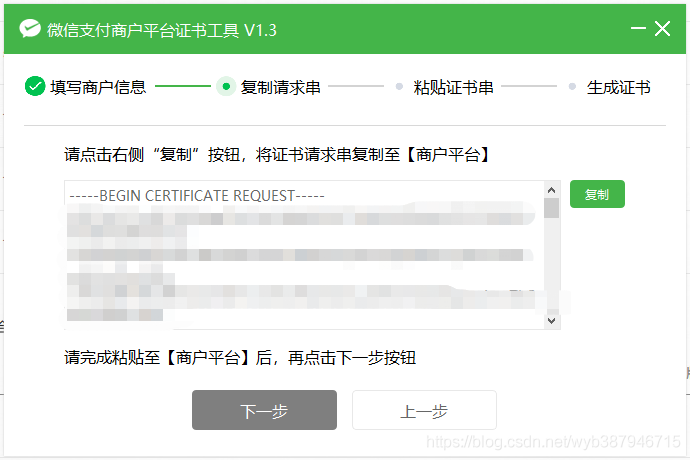 將證書請求串進行復制,復制后回到上述微信支付后臺申請API證書頁面,將請求串進行復制,經測試自動幫你完成復制粘貼,請求串復制后點擊“下一步”操作,進入復制證書串步驟,如下圖
將證書請求串進行復制,復制后回到上述微信支付后臺申請API證書頁面,將請求串進行復制,經測試自動幫你完成復制粘貼,請求串復制后點擊“下一步”操作,進入復制證書串步驟,如下圖 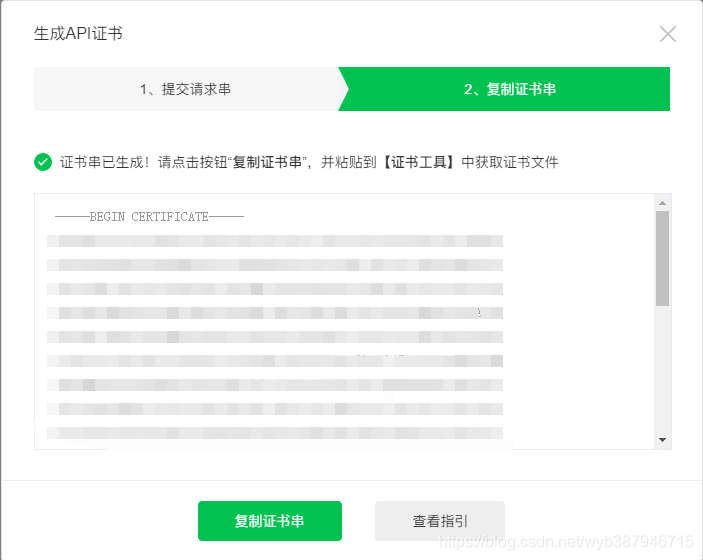 點擊“復制證書串”,將復制的證書串粘貼至證書工具中,如下圖
點擊“復制證書串”,將復制的證書串粘貼至證書工具中,如下圖 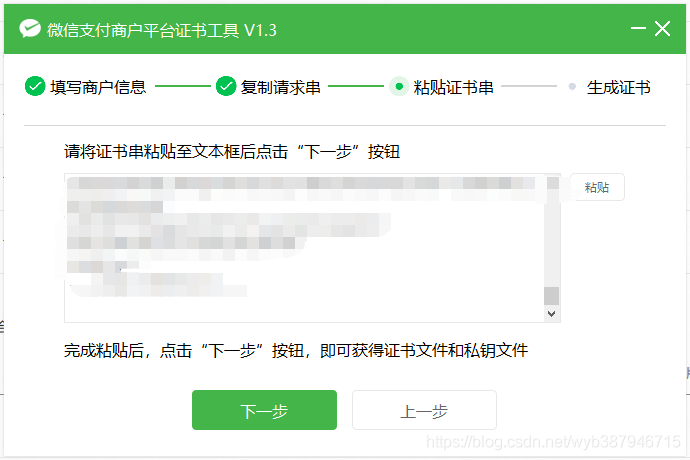 點擊“下一步”完成商戶證書的申請,如下圖
點擊“下一步”完成商戶證書的申請,如下圖 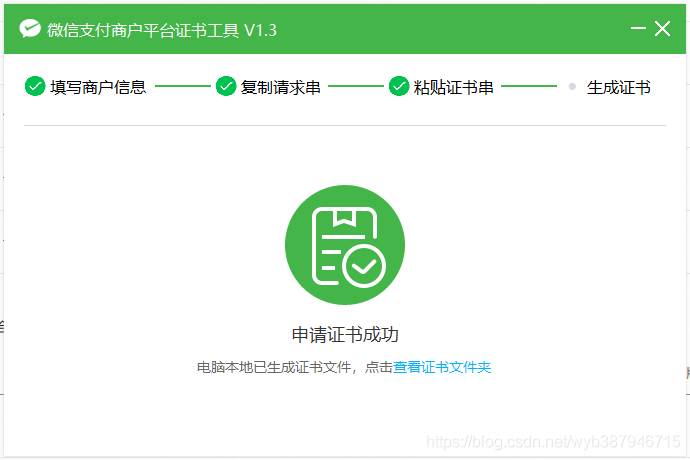 商戶API證書已生成,點擊查看證書文件夾,即可查看證書信息,如下圖
商戶API證書已生成,點擊查看證書文件夾,即可查看證書信息,如下圖  在微信支付商戶后臺可獲取商戶API證書序列號及證書有效期,如下圖
在微信支付商戶后臺可獲取商戶API證書序列號及證書有效期,如下圖 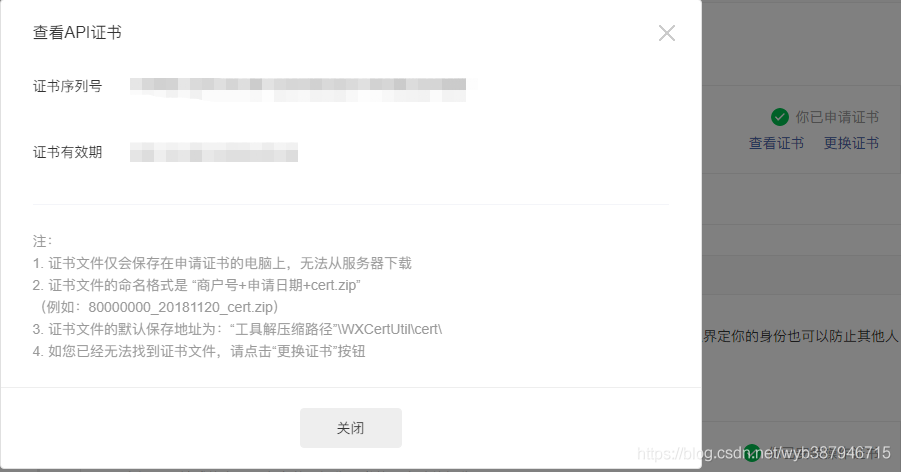
設置API密鑰,現階段由于微信支付原先老接口并未全部升級至API v3版,涉及新老接口共存的情況,所以API密鑰及APIV3密鑰都需進行設置,新老接口請查閱微信支付開發文檔 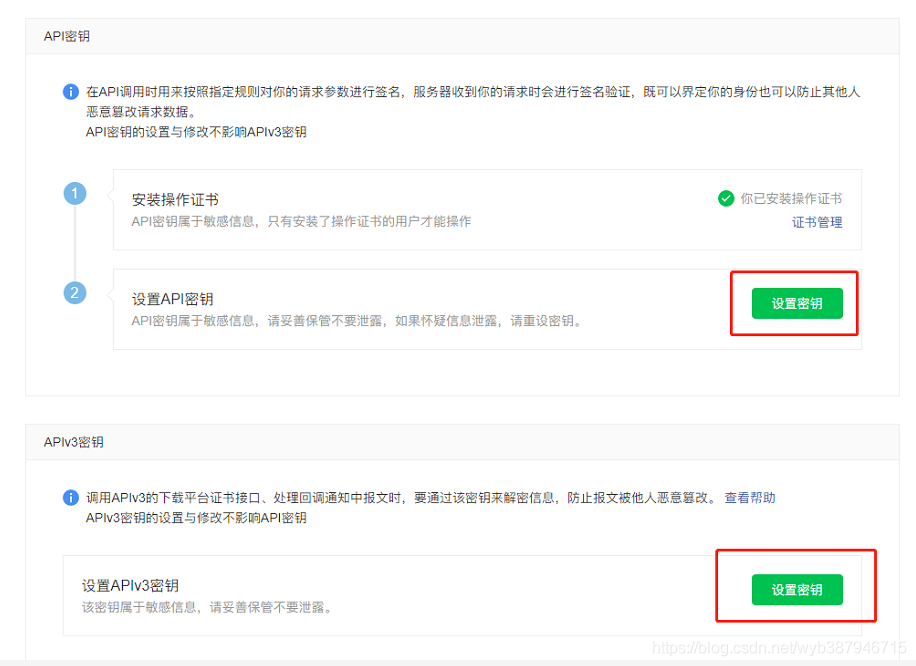 API v2老版本密鑰設置
API v2老版本密鑰設置 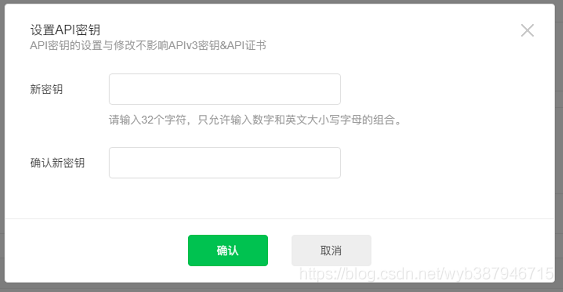 API v3密鑰設置
API v3密鑰設置 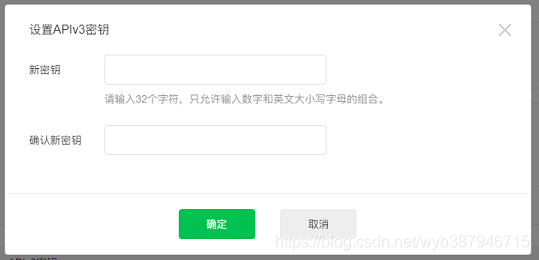
微信平臺證書下載,查閱開發文檔,微信已提供證書下載工具 如下圖 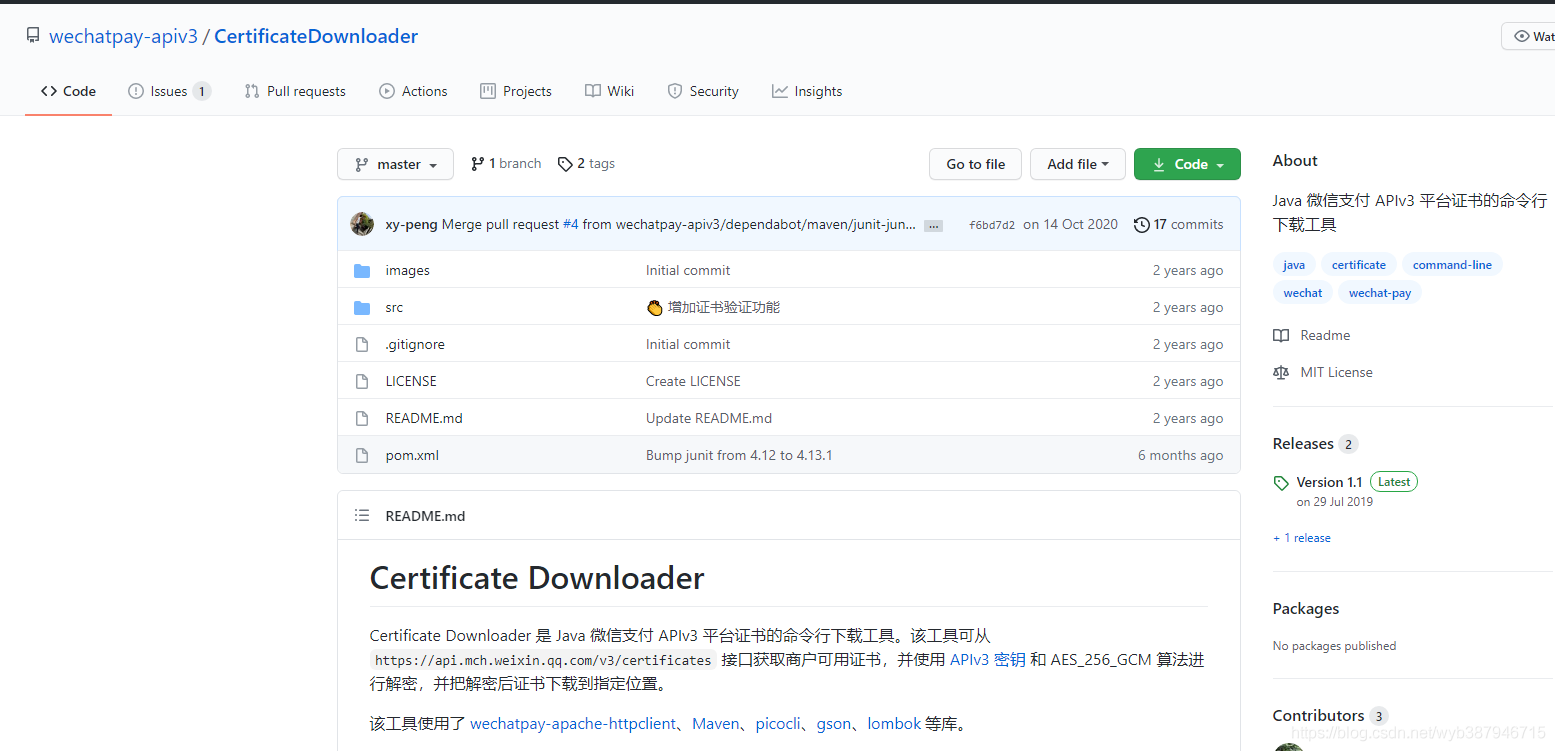
關注本文末尾微信公眾號,回復“666”獲取常用開發工具包,內含常用開發組件及微信證書下載工具,節省下載時間。
下載平臺證書至本地,執行命令
必需參數有:
商戶的私鑰文件,即 -f (商戶API證書中apiclient_key.pem文件路徑)
證書解密的密鑰,即 -k (微信支付后臺設置的APIv3密鑰)
商戶號,即 -m (微信支付商戶號,可在微信支付后臺查閱)
保存證書的路徑,即 -o (微信平臺證書保存路徑)
商戶證書的序列號,即 -s (商戶API證書,即上述第一步申請商戶API證書序列號)
非必需參數有:
微信支付證書,用于驗簽,即 -c
完整命令如下
java -jar CertificateDownloader-1.1.jar -k ${apiV3key} -m ${mchId} -f ${mchPrivateKeyFilePath} -s ${mchSerialNo} -o ${outputFilePath}至此基礎配置參數已準備就緒
在請求接口之前先了解下接口中一些參數概念,首次接觸最容易搞混的就是商戶API證書和平臺證書,如下圖 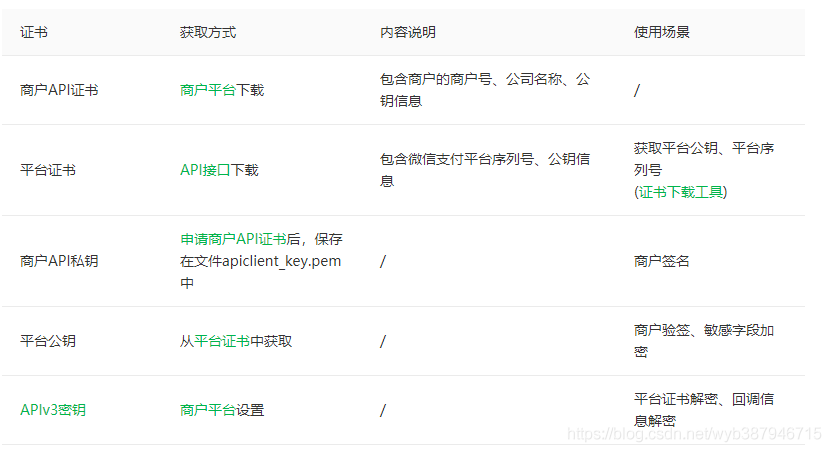
以往老吐槽微信支付接口文檔不友好,沒有sdk,現在API v3版本給你提供了一個客戶端,這點還是可以點贊的,對于開發人員來說,demo代碼直接拿過來,更改下配置參數就可以跑通,那簡直是對程序員莫大的關懷,這方面阿里相對做的比較好
talk is cheap, show me the code
以post請求方式說明,get請求類似
private static String basePostRequest(String requestUrl,String requestJson) {
CloseableHttpClient httpClient = null;
CloseableHttpResponse response = null;
HttpEntity entity = null;
try {
PrivateKey merchantPrivateKey = PemUtil.loadPrivateKey(new ByteArrayInputStream(privateKey.getBytes("utf-8")));
X509Certificate wechatpayCertificate = PemUtil.loadCertificate(new ByteArrayInputStream(certificate.getBytes("utf-8")));
ArrayList<X509Certificate> listCertificates = new ArrayList<>();
listCertificates.add(wechatpayCertificate);
httpClient = WechatPayHttpClientBuilder.create()
.withMerchant(mchId, mchSerialNo, merchantPrivateKey)
.withWechatpay(listCertificates)
.build();
HttpPost httpPost = new HttpPost(requestUrl);
// NOTE: 建議指定charset=utf-8。低于4.4.6版本的HttpCore,不能正確的設置字符集,可能導致簽名錯誤
StringEntity reqEntity = new StringEntity(requestJson, ContentType.create("application/json", "utf-8"));
httpPost.setEntity(reqEntity);
httpPost.addHeader("Accept", "application/json");
response = httpClient.execute(httpPost);
entity = response.getEntity();
return EntityUtils.toString(entity);
} catch (Exception e) {
e.printStackTrace();
} finally {
// 關閉流
}
return null;
}方法中涉及參數說明
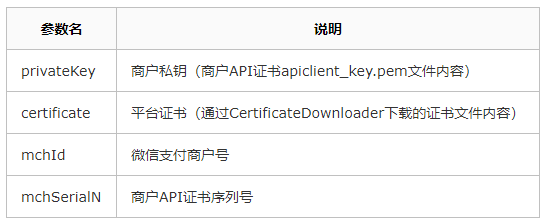
PemUtil.java類為com.wechat.pay.contrib.apache.httpclient.util.PemUtil
請求簽名及應答簽名校驗該客戶端均已幫你處理好,心中對微信支付開發文檔有了一點點好感。根據具體接口方法傳入接口地址及相應接口參數JSON數據即可完成接口聯調測試。
以小程序調起支付接口為例,簡單說明參數簽名方式,先看下文檔中簽名是怎么說的,如下圖 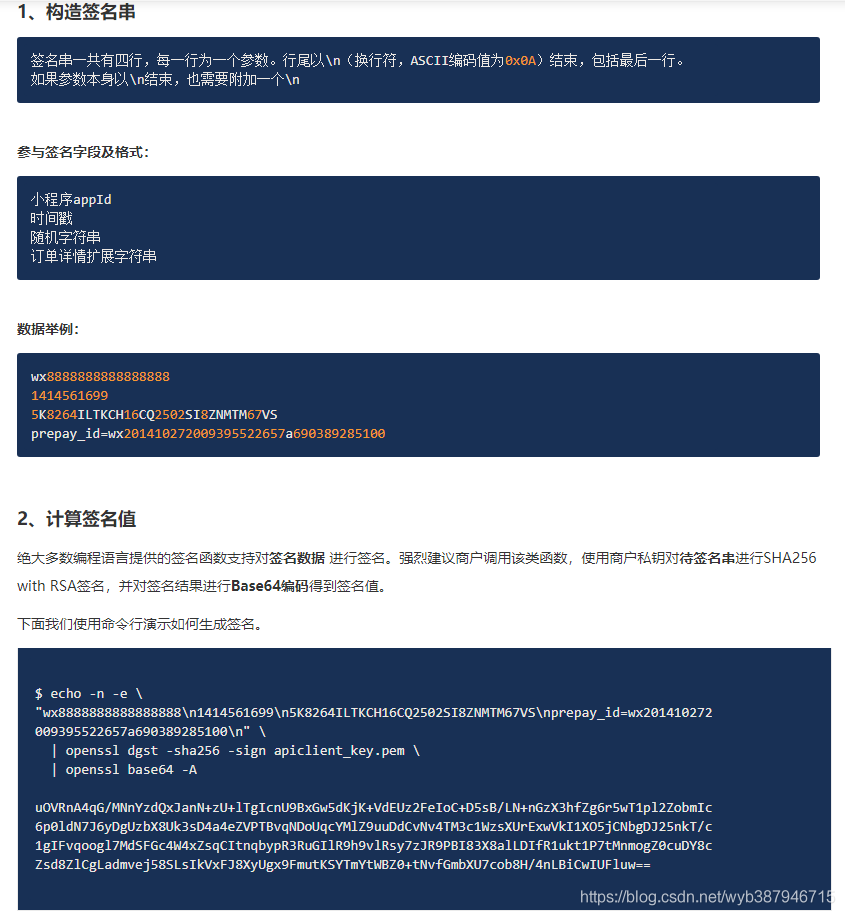
/**
* 微信支付-前端喚起支付參數
* prepay_id=wx201410272009395522657a690389285100
* @param packageStr 預下單接口返回數據 預支付交易會話標識 prepay_id
* @return
*/
public static Map<String,Object> createPayParams(String packageStr) {
Map<String,Object> resultMap = new HashMap<>();
String nonceStr = StringUtil.getUUID();
Long timestamp = System.currentTimeMillis() / 1000;
String message = buildMessage(timestamp, nonceStr, packageStr);
String signature = null;
try {
signature = sign(message.getBytes("utf-8"));
} catch (UnsupportedEncodingException e) {
e.printStackTrace();
}
resultMap.put("appId", appId);
resultMap.put("timeStamp",timestamp.toString());
resultMap.put("nonceStr",nonceStr);
resultMap.put("package",packageStr);
resultMap.put("signType","RSA");
resultMap.put("paySign",signature);
return resultMap;
}
/**
* 微信支付-前端喚起支付參數-簽名
* @param message 簽名數據
* @return
*/
public static String sign(byte[] message) {
try{
Signature sign = Signature.getInstance("SHA256withRSA");
sign.initSign(getPrivateKey(keyFilePath));
sign.update(message);
return Base64.getEncoder().encodeToString(sign.sign());
} catch(Exception e) {
e.printStackTrace();
}
return null;
}
/**
* 微信支付-前端喚起支付參數-構建簽名參數
* @param nonceStr 簽名數據
* @return
*/
public static String buildMessage(long timestamp, String nonceStr, String packageStr) {
return appId + "\n"
+ timestamp + "\n"
+ nonceStr + "\n"
+ packageStr + "\n";
}
/**
* 微信支付-前端喚起支付參數-獲取商戶私鑰
*
* @param filename 私鑰文件路徑 (required)
* @return 私鑰對象
*/
public static PrivateKey getPrivateKey(String filename) throws IOException {
String content = new String(Files.readAllBytes(Paths.get(filename)), "utf-8");
try {
String privateKey = content.replace("-----BEGIN PRIVATE KEY-----", "")
.replace("-----END PRIVATE KEY-----", "")
.replaceAll("\\s+", "");
KeyFactory kf = KeyFactory.getInstance("RSA");
return kf.generatePrivate(
new PKCS8EncodedKeySpec(Base64.getDecoder().decode(privateKey)));
} catch (NoSuchAlgorithmException e) {
throw new RuntimeException("當前Java環境不支持RSA", e);
} catch (InvalidKeySpecException e) {
throw new RuntimeException("無效的密鑰格式");
}
}方法中涉及參數說明
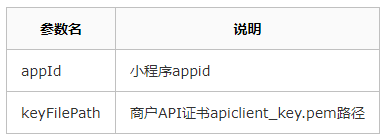
回調通知涉及驗簽及解密
回調數據獲取
String body = request.getReader().lines().collect(Collectors.joining());
驗簽
/**
* 回調驗簽
* https://pay.weixin.qq.com/wiki/doc/apiv3/wechatpay/wechatpay4_1.shtml
* @param wechatpaySerial 回調head頭部
* @param wechatpaySignature 回調head頭部
* @param wechatpayTimestamp 回調head頭部
* @param wechatpayNonce 回調head頭部
* @param body 請求數據
* @return
*/
public static boolean responseSignVerify(String wechatpaySerial, String wechatpaySignature, String wechatpayTimestamp, String wechatpayNonce, String body) {
FileInputStream fileInputStream = null;
try {
String signatureStr = buildMessage(wechatpayTimestamp, wechatpayNonce, body);
Signature signer = Signature.getInstance("SHA256withRSA");
fileInputStream = new FileInputStream(weixin_platform_cert_path);
X509Certificate receivedCertificate = loadCertificate(fileInputStream);
signer.initVerify(receivedCertificate);
signer.update(signatureStr.getBytes(StandardCharsets.UTF_8));
return signer.verify(Base64.getDecoder().decode(wechatpaySignature));
} catch (Exception e ) {
e.printStackTrace();
} finally {
if (fileInputStream != null) {
try {
fileInputStream.close();
} catch (IOException e) {
e.printStackTrace();
}
}
}
return false;
}
/**
* 回調驗簽-加載微信平臺證書
* @param inputStream
* @return
*/
public static X509Certificate loadCertificate(InputStream inputStream) {
try {
CertificateFactory cf = CertificateFactory.getInstance("X509");
X509Certificate cert = (X509Certificate) cf.generateCertificate(inputStream);
cert.checkValidity();
return cert;
} catch (CertificateExpiredException e) {
throw new RuntimeException("證書已過期", e);
} catch (CertificateNotYetValidException e) {
throw new RuntimeException("證書尚未生效", e);
} catch (CertificateException e) {
throw new RuntimeException("無效的證書", e);
}
}
/**
* 回調驗簽-構建簽名數據
* @param
* @return
*/
public static String buildMessage(String wechatpayTimestamp, String wechatpayNonce, String body) {
return wechatpayTimestamp + "\n"
+ wechatpayNonce + "\n"
+ body + "\n";
}方法中涉及參數說明

解密
// https://pay.weixin.qq.com/wiki/doc/apiv3/apis/chapter3_1_5.shtml
AesUtil wxAesUtil = new AesUtil(apiv3.getBytes());
String jsonStr = wxAesUtil.decryptToString("associated_data".getBytes(),"nonce".getBytes(),"ciphertext");方法中涉及參數說明
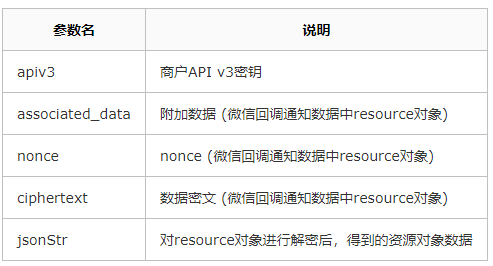
“如何使用API v3接口”的內容就介紹到這里了,感謝大家的閱讀。如果想了解更多行業相關的知識可以關注億速云網站,小編將為大家輸出更多高質量的實用文章!
免責聲明:本站發布的內容(圖片、視頻和文字)以原創、轉載和分享為主,文章觀點不代表本網站立場,如果涉及侵權請聯系站長郵箱:is@yisu.com進行舉報,并提供相關證據,一經查實,將立刻刪除涉嫌侵權內容。